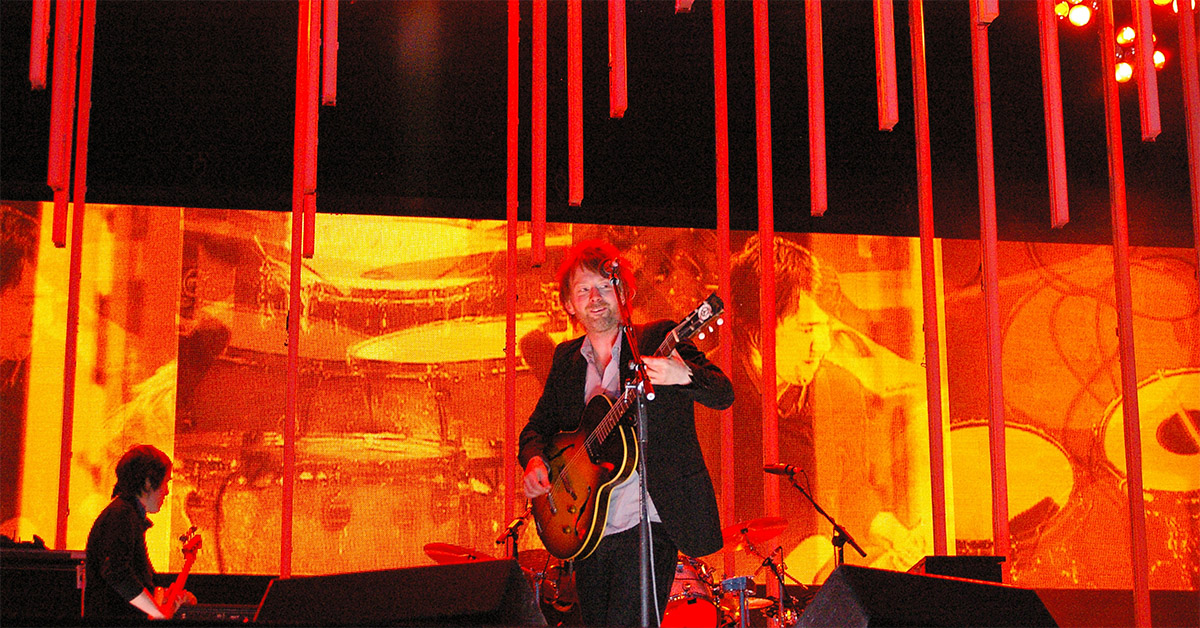Radiohead are onboard.earth heroes: pioneers of measuring, and reducing their tour travel emissions they also took their audiences and crew on the journey with them, promoting “carbon light” forms of travel to events, incentivising the use of public transport and pointing ticket-buyers to carbon calculators similar to onboard.earth’s to learn more about their travel choice impacts:
In 2007 Radiohead paved the way for green touring by commissioning sustainability agency “Best Foot Forward” to calculate the carbon footprint of two previous US tours and create a map for a future, greener, tour. In addition to the band and crew, the report also considered travel to the location and the consumption of visitors.
Radiohead’s 2003 theatre tour (19 shows in city centres) and the 2006 amphitheatre tour (12 shows at isolated venues) served as the basis for the evaluation.
The theatre tour produced a total of 2,295 metric tons of CO2 and the amphitheatre tour accounted for 9,073 metric tons of CO2. As predicted travel was overwhelmingly the biggest factor with fans generating 86% of the CO2 emissions of the theatre tour and 97% for the amphitheatre tour – mainly due to car travel emissions. Most of the emissions generated by the band & the crew also came from travelling.
During the course of the data collection, scenarios for future tours were compiled and, in 2008, Radiohead embarked on a tour with a comprehensive environmental concept aiming for the first, “Carbon Neutral World Tour.”
To reduce emissions from audience travel, concerts were held exclusively in cities/urban areas with good public transport links. As an incentive fans arriving with a public transport were offered earlier admission – the incentive was promoted through a communications campaign along with an appeal to fans coming by car to liftshare. A CO2 calculator, similar to onboard.earth’s Travel Carbon Calculator, and information on climate change was added to online channels and ticket purchase links.
To cut transport from crew and production travel two equipment sets were rented – one for Europe, one for America and sound systems were hired locally for each tour country to reduce the need for trans-Atlantic shipping & freight.
Careful planning meant that freight shipping weights dropped from a former 20 metric tons to only one metric ton. The most efficient routes were taken between tour venues in order to avoiding crew flights and tour trucks were chosen for their efficiency and powered by biofuel where possible.
The tour team also worked closely with the venues to target energy, waste and water emissions (you can read the full report HERE).
Radiohead didn’t just reduce the emissions from their tour – they included fans and crew in the issue, educating and encouraging them to change things in their daily lives as well. This wider messaging is a central part of onboard.earth’s mission; We believe the live events industry has the potential to inspire and educate millions of people each year, highlighting key issues and showing leadership by taking action on the climate crisis.
Photo credit: Nicolas Lœuillet, CC BY-SA 2.0, via Wikimedia Commons
Sources: The Guardian, 2007, Radiohead seek to reduce global impact
Radiohead archive: Best Foot Forward

